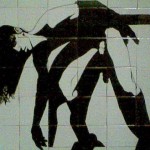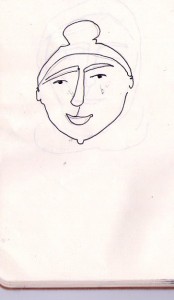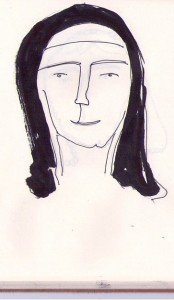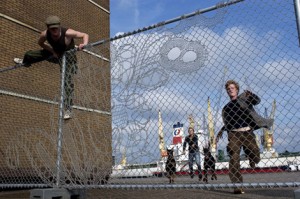![]()
Icons are images or representations, symbols linked to commands or signs that stand for its object by virtue of a resemblance to it. Classic icons in folklore are for example the tulips that form always an instant link in our minds to the Netherlands. A similar icon is the cross for Christianity or the peace-symbol for the hippies. What are the main icons of today’s folklore? Which symbols will in decades to come remind us of this time? In our day and age the borders between countries are becoming less eminent with globalization and through the Internet communication is becoming ever faster. To deal with this intercultural computer-based community we are all becoming a part of, icons are vital in order to simplify for us these machines and also to express emotion in a typed conversation. Computer icons and emoticons are designed icons with a history, they are very important to our time and they will continue to be the true icons of modern folklore.
Archive for October, 2009
The Icons of Modern Folklore
Wednesday, October 14, 2009
Hoofddeksel geliefd bij gelovigen
Wednesday, October 14, 2009
(Headwear popular with believers)
Why do people, both men and women, cover their hair or head for religious purposes?
Do they all have the same reason? Why are the rules different for men and women and what does it mean that we all want to cover this part of our body that is in first appearance not the most intimate one?
And finally what do have the differences between religions, but even the differences within one religion, to do this?
Alexander van Slobbe
Wednesday, October 14, 2009
The Designer is necessary!
Looking at Alexander van Slobbe and the role of the designer as he sees it, the two most important words seem to be innovation and approach. The innovation of the designer, in the approach to the garments and silhouette’s of the line. It is here, according to van Slobbe, that you find the importance of the designer. “For to long fashion has embraced the ideology that all innovation comes off the street” says van Slobbe and “thin conception would render the designer unnecessary”. So what then does innovation mean in relation to fashion? Trying to contemplate this, using the light blue line of 1994 as a starting point, the answer must be to remember the difference between innovation and invention.
LACE
Wednesday, October 14, 2009
Lace, does it need a presentation?
The history or origin… it is antique but not really clear where it came from, used in many culture, with conotation, with meaning, with symbolism.
The different types… Needle Lace, Cutwork, Bobbin Lace, Tape Lace, Knotted Lace, Crocheted Lace or Machine Lace.
The intention… manually made visual decoration.
Many things can be said about it’s past but is it really that important?
Let’s focus on the influence of lace in our future.
Lace, as every one knows it, is used for clothing and accessories, in folklore or modern fashion design but that is not the only place where the lace is used. In present time its presents can be found in art, architecture or even in contemporary design.
The “Lace Fence”, developed by the Dutch design house Demakersvan, is one of the works that was influenced by classic lace. This fusion between the industrial metal fence and lace embroidery modifies and cultivates a different look to our environment. What it achieves is, hostility versus kindness, industrial versus craft.
FOLKLORE : folkeminder, folclore, pjódfrædi, folklor…..
Wednesday, October 7, 2009
The dictionary of cultural & cultural theory (Michael Payne, ’96) does not mention folklore but it does describe Folk culture. According to this dictionary folk culture is the culture of preindustrial (premarket, precommodity) communities. It was therefore taken to be organized around a number of characteristics: the oral transmission of songs, tales and history: aesthetic authorization by tradition, the integration of nature and culture, body and mind, expression through ritual in the collective deployment of symbols.
Folk is not an antropological term. It is an ideological construct; it necessarity includes a critique of ‘modern’ societies. As an aspect of nationalist ideology, folk culture is taken to be expressive of the true spirit of the nation, of it’s underlying beliefs and values, as articulated in specific forms of dress, speech, music, story telling, cookery and design.
The Idea of folk culture was taken up by Marxists, in the construction of working class consciousness (folk=serfs+peasants). Folk culture could be presented as the ‘pure’ form of working class culture untouched by the seductions of commerce.
A lot of comtemporary designers are inspired by this so called ‘pure’ form of working class culture. Remarkable designers worldwide (from Iceland to Denmark to Holland and Afghanistan) are interested in folklore, local crafts and methods. You will find this in the designs by ao Viktor & Rolf, Alexander van Slobbe and Claudy Jongstra, see a short documentary ‘Felt fabric and furniture’ where she shows the traditional techniques she’s working with: http://www.dutchprofiles.com/video/. This site also shows a film ‘African Beauty in Dutch design’ on the textile manufacturer Vlisco.
The most common idea of folk culture today is as a tourist attraction, a way of signaling what makes a country or locale different. But it’s definitely more then that. Folk culture is more then a kind of domesticated exotica, artificially preserved by the state. It seems to have noteworthy relations with design, its concepts, meaning and ideals.
The Dutch House Scene
Wednesday, October 7, 2009
The Netherlands is well known for its liberal thoughts and its sense of the ability of living a free life. I would like to go back to a period in time where I believe that this feeling of freedom started. Well, at least for me it started in this period. And after having seen  in the Zuiderzeemuseum some memories came back to me.
in the Zuiderzeemuseum some memories came back to me.
In the beginning of the 90s a new form of dancing and partying was developing worldwide: ‘The House scene’. The Netherlands, and especially Amsterdam, was an important spill in this scene. Clubs like ‘The Roxy’ and ‘The It’ were internationally well known and formed the basis of experimenting within all boundaries of partying. In these clubs it felt as if all things were possible and all different types of people were accepted. This also attracted many homosexuals from all over the world to come to Amsterdam. Which led to an extravagant gay scene that gave these dance parties a free and exceptional character.
(house scene back in the early 90’s filmed in The Roxy)
Until today many people try to redevelop the feeling we experienced back in the 90s by organising the same types of parties. Dressing up, drugs, gays, extravagant shows, and all other sorts of things are organised in order to recreate that great sense of freedom. In my opinion: ‘Dutch folklore that developed into a worldwide dance scene’.





